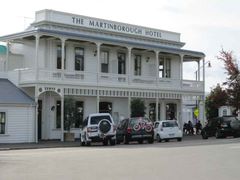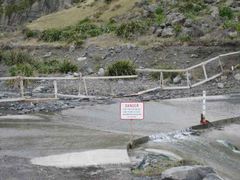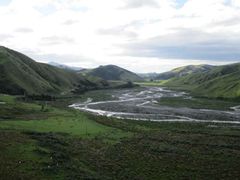Cape Palliser

The Wairarapa district has undergone something of a renaissance over the last few decades, with the burgeoning wine industry attracting weekenders from nearby Wellington. Nowadays farm supply stores jostle for main street position with boutique eateries and designer stores. Perhaps nowhere is this transformation more evident than at its viticultural epicentre, Martinborough, whose main street is now almost entirely given over to fine dining. You are now in one of New Zealand's premiere wine growing regions - enjoy!
This trip starts and ends in Martinborough, exploring some of the more rugged and remote parts of the Wairarapa coastline and taking in some iconic sights along the way. At times challenging, but infinitely rewarding. Leave all but the essentials at the campground in Martinborough (you'll be thankful for the lighter load once you hit the hills on the return leg). But don't skimp on warm-weather gear - the weather here gets wild and the coast is very exposed.

Most of this route can be ridden on a standard touring bike, but to do the complete loop you will need to ride the 10 or so km of 4WD track between Cape Palliser and White Rock, and for this you're really better off with the fatter tyres of a mountain bike. But don't let that put you off - we're not talking full-on knobbly tyres here; I've ridden the route comfortably with slicks (and well-laden panniers).
From the main square in Martinborough head out along Jellicoe Street, which soon turns into Lake Ferry Road. The riding is nice and flat with only minor rises and falls as you pass through farmland and vineyards. At around 28 km you come to Pirinoa where there is a general store, then a further 4 km brings you to the Cape Palliser Road turnoff. If you want a very short first day then instead of taking the turnoff you can continue a further 4 km down to the end of Lake Ferry Road and the Lake Ferry Hotel with a campground set on the banks of Lake Onoke.

Soon after the turnoff the road rises to about 150 metres, offering excellent views out to Cape Palliser before descending down to the coast and the Putangirua Pinnacles DOC campground. Here there is a 2 hour bush-walk to a series of pillars (or hoodoos) caused by erosion over millions of years. An interesting excursion and well worth the effort.
Now that the Ngapotiki hut has closed (see below) this is probably the best camping option for the night. This campground is popular though, so be prepared for noise and perhaps take some earplugs.
From the Pinnacles campground the road carries on a further 17 km around the coastline, passing through a few small settlements before reaching the beautiful fishing village of Ngawi, noted for the bulldozers which line its shore front.
After Ngawi the tarmac gives way to gravel. A little way out there is a ford to cross and soon after you come to a seal colony (one of several along this coast), then 7 km from Ngawi you reach Cape Palliser and its iconic lighthouse. This is as far as cars can go because here the road turns into a 4WD track.

The 4WD track follows the coastline east from Cape Palliser, passing through a surprising variety of terrain, ranging from grassy flats to boulder fields to tussocky sand. There's one stream to cross (the Waitetuna Stream) and a few sections of the track are a bit rough or pass over soft sand, but mostly the track is navigable. Towards the White Rock end you come to the site of the old DOC-run Ngapotiki Hut. Alas, the hut has been taken down although DOC still allow camping on site, albeit with the warning to take extreme care with gas cookers. There are some good spots here to pitch a tent, but with no water or amenities this option is not for everyone. It's at this point though that this trip really comes alive for me. Yes, Ngawi and Cape Palliser alone make the trip worthwhile, but there is something magical about spending a night in this remote spot. Lonely, dramatic and starkly beautiful.

This part of the coast gets some great sea swells so is popular with surfies, and you're likely to encounter one or two out to spend a day in the water. The 4WD track used to be open to all traffic but now there are a couple of big metal gates at the White Rock end, apparently put up because some surfies were causing a bit of strife for the local farmer. Apart from the informal DOC campground at Ngapotiki most of the track from Cape Palliser to White Rock runs through private land. Be respectful of this and especially careful around any livestock.
At White Rock you rejoin the main road again - gravel, but well graded. Here you turn inland to follow the braided Opouawe River upstream as you head the remaining 50 km along quiet country roads through to Martinborough. At Tuturumuri the road returns to tar seal. There are a couple of fairly taxing hills to climb before you reach Martinborough again. At the top of the highest there is the option to take a small detour along Range Road and see the Haunui wind farm.
This is a wonderful ride. Challenging in parts - especially if the wind is up - but also rugged, beautiful and rewarding.